A dislocated ankle happens when the bones forming the ankle joint are forced out of their normal position. This injury can involve damage to ligaments, tendons, and sometimes fractures of the surrounding bones. Because of the complexity of the ankle joint, recovery time can vary widely depending on severity, treatment, and how well rehabilitation goes.
Typical Recovery Timelines
Recovery from a dislocated ankle depends on whether there’s also a fracture, how much soft tissue was damaged, and whether surgery is required.
- Mild to moderate dislocations: Usually take about 8–12 weeks before returning to normal daily activities.
- Severe dislocations (with fracture or surgery): Often require 3–6 months or longer for full recovery.
- Athletes and high-impact activity: Returning to sports can take 6–12 months, depending on rehabilitation progress and joint stability.
Even after the joint heals, mild soreness, stiffness, and swelling can persist for months as the body regains strength and mobility.
Recovery Phases
| Phase | Timeframe | Focus | Common Steps |
|---|---|---|---|
| Acute phase | First few days to 2 weeks | Reduce swelling and immobilize the ankle | Rest, ice, compression, elevation, and immobilization with a boot or cast |
| Healing phase | Weeks 2–6 | Tissue repair and limited movement | Begin gentle range-of-motion exercises and non-weight-bearing activities |
| Rehabilitation phase | Weeks 6–12 | Regain flexibility and strength | Physical therapy, stretching, and gradual return to weight-bearing |
| Sport-specific training | 3 months and beyond | Restore agility and balance | Strength work, proprioception drills, and progressive sport-specific movement |
Each recovery plan is customized, and rushing the process can lead to chronic instability or re-injury.
Factors Affecting Recovery Time
- Severity of the injury: The more severe the damage, the longer recovery takes.
- Surgery requirements: Surgical repairs for fractures or ligament tears extend healing time.
- Age and health: Younger and healthier individuals tend to recover faster.
- Rehabilitation consistency: Regular physical therapy greatly speeds up recovery.
- Previous ankle issues: Prior sprains or chronic instability can slow progress.
Case Highlight: Fred Warner’s Dislocated Ankle
A recent high-profile example is San Francisco 49ers linebacker Fred Warner, who suffered a dislocated and broken ankle during the 2025 NFL season. The injury was described as season-ending, with early estimates suggesting a three-month recovery window following surgery.
For elite athletes like Warner, recovery isn’t just about walking again — it’s about regaining explosive movement, balance, and confidence to perform at a professional level. While three months may be enough for basic healing, full return to top performance can take much longer, depending on physical therapy and conditioning.
Warner’s situation underscores how demanding and delicate ankle recovery can be, even for world-class athletes with access to top medical teams.
How to Support Recovery
- Follow medical guidance strictly. Never rush weight-bearing or exercise before your doctor approves.
- Stay consistent with physical therapy. Rebuilding stability and strength is crucial to avoid re-injury.
- Use supportive footwear or braces. These help protect the joint as you transition back to normal activity.
- Eat a nutrient-rich diet. Protein, vitamin C, and calcium support tissue repair.
- Monitor swelling and pain. Persistent swelling could signal delayed healing or overuse.
Summary
- Mild dislocations: Heal in 2–3 months
- Severe or surgical cases: Often require 3–6 months or more
- Athletes like Fred Warner: May need up to a year for full athletic recovery
Recovering from a dislocated ankle takes time, patience, and proper rehabilitation. While everyday activities can resume within a few months, full strength and confidence — especially for high-performance athletes — may take significantly longer.

